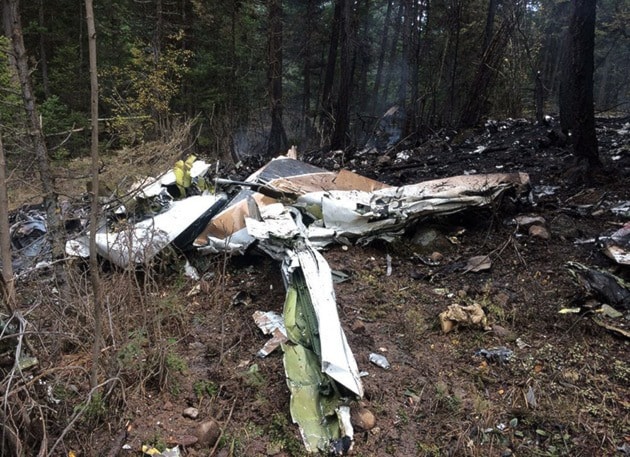Wreckage from last week's plane crash north of Kelowna will be removed this week by helicopter and transported to a facility for further analysis, now that the Transportation Safety Board has completed the field work portion of the investigation.
"We will be thorough in our analysis of the data we have collected, and will continue to gather information as the investigation progresses", said Beverley Harvey, the Transportation Safety Board's Investigator-in-Charge, in a press release.
Here are some important next steps in that investigation:
- Review drone images—filmed with the assistance of the RCMP
- Examine components such as instrumentation and any device that contains non-volatile memory
- Send selected wreckage to the TSB Laboratory in Ottawa for further analysis
- Gather additional information about weather conditions
- Gather information on air traffic control communications and radar information
- Examine aircraft maintenance records
- Examine pilot training, qualifications, proficiency records and medical history
- Continue interviews with witnesses, the aircraft operator and others
- Review operational policies and procedures
- Examine the regulatory requirements
- Create simulations and reconstruct events to learn more about the accident sequence (i.e., to validate data, test hypotheses, and verify assumptions)
The field investigation, said the TSB, already involved a number of partners, including the plane and engine manufacturer.
The National Transportation Safety Board (NTSB) of the United States, as State of Design and Manufacture of the aircraft, appointed an Accredited Representative to the TSB investigation. Representatives from the aircraft manufacturer assisted on site as technical advisors to the US Accredited Representative Technical experts from the engine manufacturer also assisted on site.
The RCMP protected the site and provided essential family liaison services. The BC Coroners Service secured the site and provided TSB investigators access so that investigation work could start right away.
The BC Coroners Service and the RCMP Forensic Search and Evidence Recovery Team conducted extremely meticulous recovery work.
A Transport Canada Minister's Observer was assigned and present at the accident site.
Former Alberta premier Jim Prentice, along with Ken Gellatly, Sheldon Reid, a shareholder in Norjet, the owner of the Cessna Citation aircraft that crashed, and Jim Kruk, associated with the 83 'Lynx' air cadet squadron all died in the crash.
The Cessna Citation private business aircraft, owned by Norjet, a Calgary-based firm, had departed Kelowna International Airport at about 8:30 p.m. Oct. 13 en route to Springbank, outside of Calgary. Kelowna RCMP and Lake Country RCMP detachments were alerted by the Surrey Air Traffic Control Centre that they had lost contact with a Citation jet shortly after its takeoff from Kelowna airport.
Cpl. Dan Moskaluk, the day following the crash, said RCMP, with the help of a police dog, were able to get to the scene just before midnight, and received assistance from local search and rescue volunteers.
"The terrain is hilly and densely forested, but we were able to access the site from a nearby forest service road," said Moskaluk.
"It was a catastrophic crash and there were no survivors."
The site of the crash was northeast of Winfield, about four kms north of Beaver Lake Road and about 18 kms north of Kelowna.
